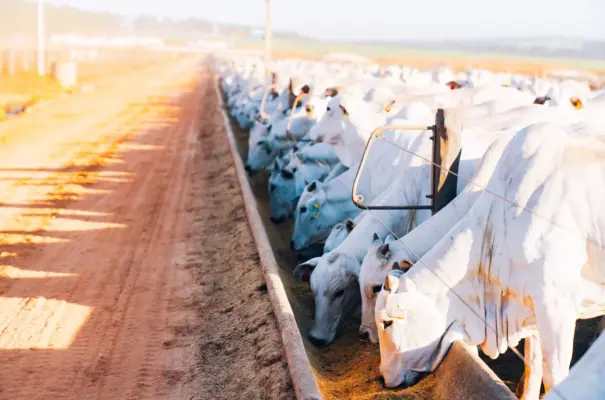Agribusiness is one of Brazil’s main economic activities and sees increasing investment in research and technology. In recent years, the country has consolidated its position as one of the world’s leading producers of beef cattle.
The area occupied by pastures reached its peak in 2007, at 173.5 million hectares. Since then – 16 years later – there has been a reduction of 18 million hectares. This decrease is a result of the expansion of agriculture and the pursuit of intensification, which highlights the need to strategically manage the transformations in the Brazilian agribusiness landscape.
Bearing in mind Brazil’s intensive livestock farming systems, cattle feedlotting – especially during the rearing and finishing phases – emerges as a strategy for producing quality meat in a smaller area and shorter timeframe (Benchmarking Confina Brasil, 2023).
However, it is worth noting that the success of this activity depends on several key characteristics, such as nutritional management, which goes far beyond simply providing a balanced diet with quality ingredients.
Feedlot nutrition: attention to the trough!
The precise provision of feed, ensuring adequate quality and quantity daily, is known as trough management. The uniformity of this management, which essentially involves “when” and “how” to feed the cattle, is directly linked to trough reading, feeding times, and the number of daily feedings (VASCONCELOS, 2007).
As cattle adapt to routine, it is recommended to standardize feeding times and avoid any delays, respecting their consumption habits. Cattle seek food most actively in the early morning, late afternoon, and at night. It is advisable to provide a larger portion during the last feeding of the day, considering that the next feeding will only be the following day.
According to data from the Benchmarking Confina Brasil 2023, across 180 surveyed properties, an average of 3.8 feedings are offered daily. The maximum division of feed reached up to 9 times a day, as seen in feedlots in the south of the country, which utilize automatic feeding systems.
The graph below shows the state average for the number of daily feedings provided by the properties surveyed by the expedition in 2023.

Source: Confina Brasil / Elaborado por Scot Consultoria
Incorrect management affects dry matter intake, which can lead to metabolic disorders, compromise herd health, and consequently increase the cost per arroba produced.
Fractioning the diet not only reduces losses but also the intensity of fatty acid production from ruminal fermentation with each meal, simply because there is less feed available to be fermented. When meals are closely spaced, ruminal pH may still be low due to the influence of fermentation from the previous meal, and a new intake of feed can easily push the pH outside the ideal range, according to the Brazilian Agricultural Research Corporation (Embrapa).
According to the institution, another important point to observe is the homogenization of the diet, which, when done correctly, prevents cattle from selecting parts of the feed that have a higher fermentation rate. This occurs when the animal selects the concentrate from the roughage or a more fermentable concentrated ingredient.
Is trough reading important?
It is recommended that readings be carried out in the morning, before the first feeding of the day, by assigning scores to the leftovers in the trough. According to the Confina Brasil 2023 benchmarking, 37% of respondents perform trough readings in the morning and adjust per pen, while 29% of them conduct two readings (daytime and nighttime) for fine-tuning, as shown in the following graph.

Source: Confina Brasil / Elaborado por Scot Consultoria
Poor mixing of ingredients, inadequate provision, and improper trough spacing – among other factors – affect consumption and, consequently, the productive efficiency of the cattle.
Hence the importance of a daily visual assessment conducted by the same, properly trained person, to avoid discrepancies in observations. It is important to have a standard, defined by the person responsible for the reading, always aiming to avoid absence or excess [of feed].
And the water?
According to Embrapa Pecuária Sudeste researcher Julio Cesar Palhares, water is the main protagonist in the context of animal nutrition. For the specialist, only after considering water should we think about feed. Much is said about pasture and the quality of grains, but little is commented on water quality, which is a contradiction in animal production.
It is uncommon in Brazil to evaluate cattle water consumption – not only the consumption itself but also the physicochemical parameters of this water. Poor water quality that animals have access to can cause diseases and even the death of young animals, in addition to impacting feed consumption, he states.
Nutrition and the bovine production tripod
Nutrition is part of the tripod – genetics, management, and nutrition – that maintains the dynamics and directly affects beef cattle production in Brazil. Many challenges encompass feed planning, such as ensuring adequate nutrient levels to ensure good cattle performance, aiming for economic efficiency.
Thus, each property must establish its ideal feeding management, in accordance with its production reality. The ingredients used, the cattle facilities, the available labor, and other relevant factors must always be taken into consideration.




